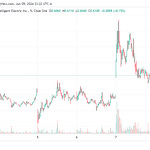Does anyone remember an old Disney movie, “Smart House?” Premiering in 1999 and starring, proper 90s heartthrob, Ryan Merriman, along with the legendary names Kevin Kilner, Rachel Duncan and Katey Sagal this movie seized the young imaginations of latch key millennials everywhere. Outside of the incredible effects, the obvious reason many Disney kids loved this movie is because in 1999, we were all getting computers in our homes for the first time, coding on myspace, and dreading the sound of the internet connection. The birth of web2, essentially. It was conceptualized long before the 90s that advanced technologies could pose a threat, but in this Disney movie, Ryan Merriman’s character was hoping that a “smart house” could solve his family’s financial problems.
Just 20 years after the premiere of this childhood movie, Satoshi Nakamoto unleashed Bitcoin into the world. Now, suddenly the refrigerators that have screens on them to show you what’s in there are finally beginning to make sense to me. Imagine yourself working to solve the same problem, how can normal people make their lives easier with the new technology of the day? Since we first began to track our heartbeat or use GPS on a Garmin, the Internet of Things (IoT) was born though the earliest example of this was in the 1980s when a Coco Cola vending machine dispensed soda from the internet. Now it is commonplace for even the homeless to have smart phones and suddenly everyone has access to the blockchain technology that Satoshi Nakamoto published into existence.
Now that we have all this data, all these computers, phones, cameras, internet, what do we do with it? We all hear about the data warehouses that shore up all our data, where its then to advertisers with no cut given to the user who provides that data. In our current situation, we are the products. Shouldn’t we benefit from this arrangement somehow, can a regular person leverage these technologies to work for them? Does everyone need to pay for Netflix account? Aren’t there some utilities, some services, some applications of real-world products that we can all share? Absolutely, there are. Welcome, you have just become a crypto and “DePIN” enthusiast in the DeFi space. Great work.
These Decentralized Physical Infrastructure Networks or “DePINs”, are arguably the next evolution of the Internet of Things (IoT) from the blockchain economy. I have begun to refer to this emerging marketplace as the “Web3 Universal Economy” or WUE (“woo-ee” for short) wherein the future will no longer consist of big corporations consuming your data with nothing in it for you. In the future, you and your neighbors could subscribe to a decentralized blockchain network with (more or less) built in network security where your fridge, your smart watch, your router, and more are all connected, enabling your data to potentially work for you while providing connectivity strength for those around you. This isn’t exactly the robot I thought it would be from Bicentennial Man, but here we are. In this world, the universal basic income that Andrew Yang discussed in his 2020 Presidential campaign could be realized with innovative solutions like these DePIN networks. An example of a compelling project to consider for the use case of this technology is Drop Wireless on the IoTeX blockchain. According to Drop Wireless CEO Andrew Baek in his interview on R3AL TALK from the IoTeX official podcast, Drop is working to drive the project “toward that sort of more distributed infrastructure,” adding that “we want to take the right steps for the bigger picture to emerge,” detailing that the crowd sharing of personally owned internet utility data is a realistic future to consider.
*It at this point that I would like to appeal to general listeners. Please note that this project has been in existence since 2018 and it has multiple competitors, meaning that any existing business that currently has a FB also has a competitor that is lightyears ahead of them in WUE already. If you are a business owner and you have NOT done your due diligence to date, I would encourage you to begin as soon as possible. *
Now, how does all of this work? Great, you can get paid for renting out your personal data, but what does that actually mean? If you know how to use a smart phone or any software application, you could potentially earn money from projects like this in the future. Practically, you’ll purchase a hardware product from Drop Wireless, such as their G2, which is commonly referred to as a “Drop Tracker,” or a wireless device, a “node,” a little computer that emits a signal to evaluate the strength of other Drop signals on the network. As your G2 assesses the strength of other signals on the network, you receive the local, $DWIN or Drop Wireless Infrastructure Network token in exchange for the Proof of Performance (PoP) your G2 device has confirmed. So basically, G2 device monitors the existing nodes on the Drop Wireless network, and validates their performance and in exchange, the network pays you its local currency. Check out this short clip from Drop Wireless discussing their product use cases, the full video is in the description below.
Now there are tons of other use cases, reward metrics, and proofs that exist with the Drop Wireless DePIN protocol on the IoTeX blockchain, so please, do your own research (DYOR) before interacting with any protocol, network, blockchain, dApp, etc. It’s just good practice to always vote with your time and your dollar. If you’d like to know more about the additional use cases for this network, the other proofs associated with it, or meet the developers, please visit their website and review the listed white paper and other documentation.
*Disclaimer* I am not affiliated with the Drop Wireless protocol, the Drop Network, IoTeX, or any of the sources cited here. This article is for educational purposes only. This is not investment or financial advice. I simply contend that this is an interesting, and potentially fruitful endeavor of the future. If you would like to know more about the technical aspects related to this project, please visit, https://dropwireless.io/ or https://iotex.io/
Sources:
https://dropwireless.io/wp-content/uploads/2023/05/WP-1.0.pdf













The Convergence of the Physical and Digital World